
The cup should not be confused with the metric cup or the teacup, which are different units of volume. The cup is a unit of volume equal to 16 tablespoons or 8 fluid ounces. The table below shows how many milligrams of various wet and dry ingredients are in a cup.Ĭup measurements converted to milligrams for commonly used cooking and baking ingredients. The actual weight of a cup will vary depending on the density of the material. Keep reading to learn more about each unit of measure. It is common to mix powdered chemicals with liquid, or aqueous, chemicals, and this is where it becomes very useful to convert between weights and volumes. When performing chemical reactions by combining separate chemicals to produce a new chemical, one must know the exact amount of each chemical to add in order to maximize the yield of the reaction. When a scale is not available, a calculator like the one above is a good way to estimate the volume to weight conversion.Īnother useful application of weight and volume conversions is chemistry. The best way to ensure an accurate conversion is to use a scale. The density of dry ingredients can vary for a variety of reasons, such as compaction and clumping. Milligrams = 5 c × 236,588.236 × 0.7 g/mL = 828,058.828 mg When to Convert Cups to MilligramsĬups and milligrams are both commonly used to measure cooking ingredients.įor cooking applications, most chefs suggest measuring dry ingredients by weight rather than volume to improve accuracy in the measurements. If the density is given in grams per milliliter (g/mL), then first multiply the density by 236,588.236 to convert to mg/c.įor a density given in g/mL, you can use this simple formula to convert: Note that in order for this to work, the density must be in milligrams per cup (mg/c). To convert a measurement in cups to milligrams, multiply the volume by the density of the ingredient or material. Therefore, to convert between cups and milligrams of an ingredient or substance, we must either multiply or divide by its density, depending on which direction we are performing the conversion. In this case, we need to account for the density of the substance whenever we do a conversion. Since cups are a unit of volume and milligrams are a unit of mass, which are different physical quantities, we need to know one more physical quantity of the ingredient or substance to convert between them. He specializes in math, science, and astrophysics.

To convert cups to grams, multiply your cups figure by 236.588 and again by the ingredient density (in g/ml).Ethan has a PhD in astrophysics and is currently a satellite imaging scientist. It all comes down to the density of the ingredient.

Salt can be as heavy as 300g, while fresh breadcrumbs would only come to 60g. Therefore, there's no single gram equivalent for a cup Than a cup of feathers (though both make for delicious pancake toppings, my toothless cousin tells me). A cup of ball-bearings will weigh much more To calculate the grams from a recipe given in cups, it's vitally important to consider what the ingredient is.
10.5 TABLESPOONS TO CUPS HOW TO
Let's look at how to convert a cup measurement to grams to get you a Bake Off-worthy cake. We've also included measurements for cups to ounces forġ cup to grams for baking ingredients 1 Cup These conversions assume that your ingredient is being spooned into the cup and reference the So, we're being super kind and providing you with some cup to gram conversions, which Advertisements We're here to helpĪs baking brethren, we need to stick together. And cake is not something to be messed around with. Ingredient in, and whether the top is heaped or levelled, baking can become a bit of a roulette game. After all, depending what country your cups are from, how tightly you pack the

It also helps youĮnsure your cake doesn't turn out somewhere between a concrete slab and a chocolate omelette. With all this confusion around cup sizes, weighing in grams becomes a much easier and more accurate way to cook.
10.5 TABLESPOONS TO CUPS CRACKED
Still with me? The mess begins before you've even cracked an egg. In the US, it's 236.59ml in recipes, but 240ml on nutritional labelling. Its more modern 250ml metric cup counterpart, now referenced in the UK as well as Australia, New Zealand, Canada and the rest of the Commonwealth. If it's an old UK recipe, it'll use the imperial cup (284.131ml), which is significantly more than In the UK, cups have rarely been used in recipes since the 1960s. To grips with the concept that is cooking with measuring cups. Are you a 'cup half-full' or a 'cup half-empty' kind of person? Hopefully, you're the former, because it's going to take some patience, hope and determination to get


 0 kommentar(er)
0 kommentar(er)
